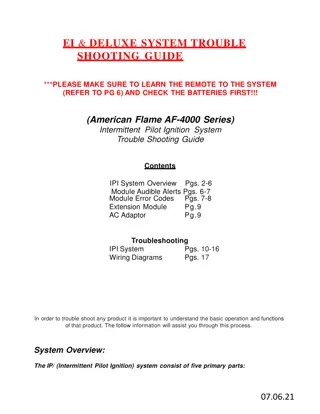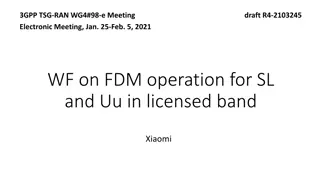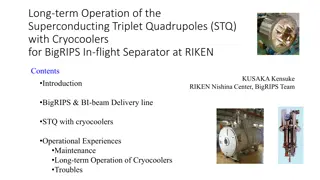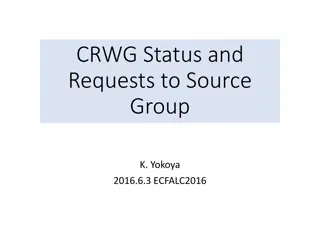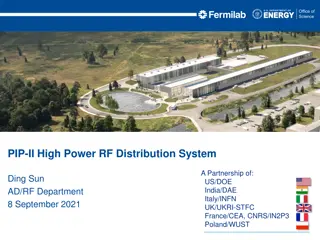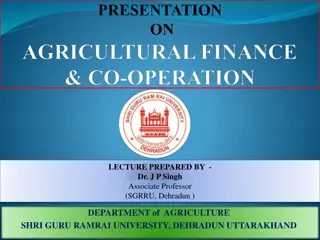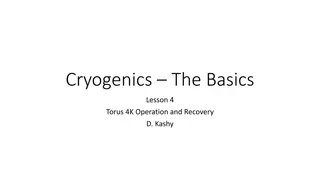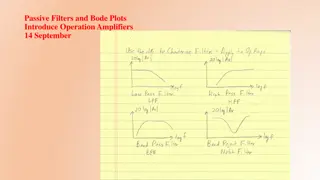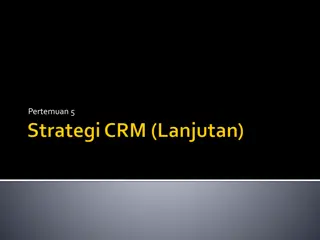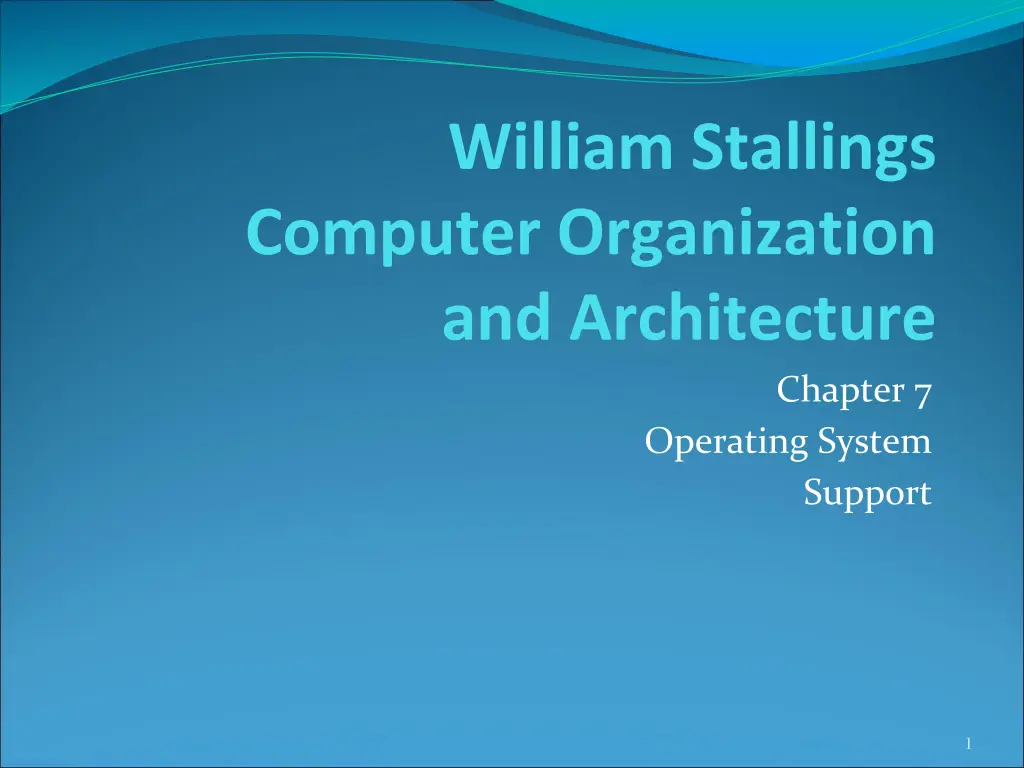
Computer Operating System Support
Explore the role and functions of an operating system, its objectives for user convenience and system efficiency, layers and views of a computer system, services provided by operating systems, and the types of operating systems. Learn about early systems, simple batch systems, and key features of kernel devices.
Download Presentation

Please find below an Image/Link to download the presentation.
The content on the website is provided AS IS for your information and personal use only. It may not be sold, licensed, or shared on other websites without obtaining consent from the author. If you encounter any issues during the download, it is possible that the publisher has removed the file from their server.
You are allowed to download the files provided on this website for personal or commercial use, subject to the condition that they are used lawfully. All files are the property of their respective owners.
The content on the website is provided AS IS for your information and personal use only. It may not be sold, licensed, or shared on other websites without obtaining consent from the author.
E N D
Presentation Transcript
William Stallings Computer Organization and Architecture Chapter 7 Operating System Support 1
Fungsi Sistem Operasi Sistem mengontrol bertindak sebagai antarmuka antara pengguna komputer dengan hardware operasi merupakan eksekusi program aplikasi yang dan program 2
Tujuan Sistem Operasi Sistem Operasi Mempunyai 2 Tujuan : ?Kenyamanan : Suatu sistem operasi membuat komputer lebih mudah digunakan ?Efisiensi : Suatu sistem operasi memungkinkan sumber daya sistem komputer dapat digunakan dengan cara yang efisien 3
Layers and Views of a Computer System 4
Layanan Sistem Operasi Pembuatan Program Eksekusi Program Access to I/O devices Akses Terkontrol ke file Akses Sistem Pendeteksi Kesalahan Akuntansi www.agungyuliantonugroho.com 5
O/S as a Resource Manager www.agungyuliantonugroho.com 6
Jenis Sistem Operasi Interactive Batch Single program (Uni-programming) Multi-programming (Multi-tasking) www.agungyuliantonugroho.com 7
Early Systems Late 1940s to mid 1950s No Operating System Programs interact directly with hardware Two main problems: Scheduling Setup time 8
Simple Batch Systems Prosesor masa awal sangat mahal, dan oleh karena itu sangat penting untuk memaksimalkan pemanfaatan prosesor. Waktu yang disia- siakan dalam kaitan dengan waktu penjadwalan dan waktu setup sangat sulit untuk diterima. Untuk meningkatkan pemanfaatan dikembangkan sistem operasi bacth sederhana. 9
Fitur-fitur perangkat keras ?Perlindungan Memori Pada saat program pengguna dieksekusi, maka program itu tidak harus mengubah area memory yg berisi monitor. Jika terjaadi perubahan area memori maka prosesor akan mendeteksi kesalahan dan kontrol transfer ke monitor ?Pengatur waktu Pengatur waktu digunakan untuk mencegah sebuah tugas memonopoli sistem ?Instruksi-instruksi istimewa Instruksi yang diistimewakan adalah instruksi I/O ?Interupsi Fitur yang memberikan SO lebih flexibel dalam melepaskan kontrol ke program pengguna dan mendapatkan kembali kontrol tersebut www.agungyuliantonugroho.com 10
Multi-programmed Batch Systems I/O devices very slow When one program is waiting for I/O, another can use the CPU 11
Multi-Programming with Two Programs 13
Multi-Programming with Three Programs 14
Time Sharing Systems Allow users to interact directly with the computer i.e. Interactive Multi-programming allows a number of users to interact with the computer www.agungyuliantonugroho.com 15
Scheduling Key to multi-programming Long term Medium term Short term I/O 16
Long Term Scheduling Determines which programs are submitted for processing i.e. controls the degree of multi-programming Once submitted, a job becomes a process for the short term scheduler (or it becomes a swapped out job for the medium term scheduler) 17
Medium Term Scheduling Part of the swapping function (later ) Usually based on the need to manage multi- programming If no virtual memory, memory management is also an issue www.agungyuliantonugroho.com 18
Short Term Scheduler Dispatcher Fine grained decisions of which job to execute next i.e. which job actually gets to use the processor in the next time slot www.agungyuliantonugroho.com 19
Process States www.agungyuliantonugroho.com 20
Process Control Block Identifier State Priority Program counter Memory pointers Context data I/O status Accounting information 21
Key Elements of O/S www.agungyuliantonugroho.com 22
Process Scheduling Process Short-Term End Long-Term Queue CPU Request Queue I/O I/O Queue I/O I/O Queue I/O I/O Queue 23
Memory Management Uni-program Memory split into two One for Operating System (monitor) One for currently executing program Multi-program User part is sub-divided and shared among active processes www.agungyuliantonugroho.com 24
Swapping Problem: I/O is so slow compared with CPU that even in multi-programming system, CPU can be idle most of the time Solutions: Increase main memory Expensive Leads to larger programs Swapping www.agungyuliantonugroho.com 25
What is Swapping? Long term queue of processes stored on disk Processes swapped in as space becomes available As a process completes it is moved out of main memory If none of the processes in memory are ready (i.e. all I/O blocked) Swap out a blocked process to intermediate queue Swap in a ready process or a new process But swapping is an I/O process... www.agungyuliantonugroho.com 26
Partitioning Splitting memory into sections to allocate to processes (including Operating System) Fixed-sized partitions May not be equal size Process is fitted into smallest hole that will take it (best fit) Some wasted memory Leads to variable sized partitions 27
Fixed Partitioning www.agungyuliantonugroho.com 28
Variable Sized Partitions (1) Allocate exactly the required memory to a process This leads to a hole at the end of memory, too small to use Only one small hole - less waste When all processes are blocked, swap out a process and bring in another New process may be smaller than swapped out process Another hole 29
Variable Sized Partitions (2) Eventually have lots of holes (fragmentation) Solutions: Coalesce - Join adjacent holes into one large hole Compaction - From time to time go through memory and move all hole into one free block (c.f. disk de- fragmentation) www.agungyuliantonugroho.com 30
Effect of Dynamic Partitioning www.agungyuliantonugroho.com 31
Relocation No guarantee that process will load into the same place in memory Instructions contain addresses Locations of data Addresses for instructions (branching) Logical address - relative to beginning of program Physical address - actual location in memory (this time) Automatic conversion using base address 32
Paging Split memory into equal sized, small chunks -page frames Split programs (processes) into equal sized small chunks - pages Allocate the required number page frames to a process Operating System maintains list of free frames A process does not require contiguous page frames Use page table to keep track 33
Logical and Physical Addresses - Paging www.agungyuliantonugroho.com 34
Virtual Memory Demand paging Do not require all pages of a process in memory Bring in pages as required Page fault Required page is not in memory Operating System must swap in required page May need to swap out a page to make space Select page to throw out based on recent history 35
Thrashing Too many processes in too little memory Operating System spends all its time swapping Little or no real work is done Disk light is on all the time Solutions Good page replacement algorithms Reduce number of processes running Fit more memory 36
Bonus We do not need all of a process in memory for it to run We can swap in pages as required So - we can now run processes that are bigger than total memory available! Main memory is called real memory User/programmer sees much bigger memory - virtual memory www.agungyuliantonugroho.com 37
Segmentation Paging is not (usually) visible to the programmer Segmentation is visible to the programmer Usually different segments allocated to program and data May be a number of program and data segments 39
Advantages of Segmentation Simplifies handling of growing data structures Allows programs to be altered and recompiled independently, without re-linking and re-loading Lends itself to sharing among processes Lends itself to protection Some systems combine segmentation with paging 40
Required Reading Stallings chapter 7 Stallings, W. Operating Systems, Internals and Design Principles, Prentice Hall 1998 Loads of Web sites on Operating Systems 41








